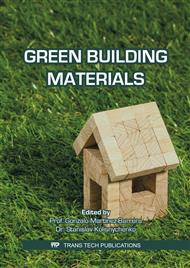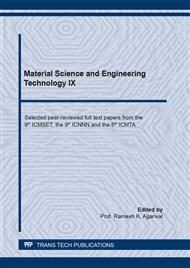p.97
p.103
p.111
p.121
p.127
p.135
p.141
p.147
p.155
Influence of Carbon Nanotubes on Traditional Material
Abstract:
Brick as a material is of vital importance in the construction industry, however, the burning processes for its preparation contribute to environmental pollution and the generation of greenhouse gases; for this reason, the present research has as aims to propose quality traditional materials for sustainable buildings through the design of soil-cement mixtures in making brick using raw materials from the amazon region of Ecuador: Centza mine (MC) and Quiringue mine (MQ) and improve the mechanical properties of the brick by incorporating carbon nanotubes, which have been dispersed in two aqueous media, sodium naphthalene sulfonate (NSS) and calcium chloride (CC) in percentages of 0.5%, 1% and 1.5%. The characterization of the raw material (analysis: physicochemical and mineralogical) was of great help. The optimum percentage of cement and water was determined through simple compression tests and soil compaction respectively. The different combinations were tested at indirect traction strength at ages 7, 14 and 28 days, determining an optimal mixture for each group of combinations, in this way the simple compressive strength of bricks has been estimated using the Griffith criterion and validation of results by finite element method applying the CivilFEM software, obtaining a resistance of 4 MPa in mixtures of SC-Ar1, 6.3 MPa in combinations of MWCNTs NSS-9 and 5.3 MPa in mixtures of CC-4 MWCNTs, increasing resistance by 57.5% and 32.5% with respect to soil-cement bricks and qualifying them as suitable for use in construction according to standars.
Info:
Periodical:
Pages:
147-154
Citation:
Online since:
March 2021
Keywords:
Price:
Сopyright:
© 2021 Trans Tech Publications Ltd. All Rights Reserved
Share:
Citation:



